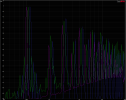I didn't want to get into this but here we go...
The plot below is a real Deluxe Reverb (green) vs. a QC (magenta) vs. an Axe-Fx III blue. This is a simple harmonic overtone test using a 1kHz sine wave (shifted up/down by one semi-tone to separate the traces) into the DUT.
If you look at the green trace (real amp) you'll see the overtones are strong all the way out to 20kHz. The Axe-Fx III's overtones are very similar in amplitude. The QC's overtones roll off starting before 10kHz. This makes the fizz less noticeable but it's less accurate.
As an aside you can see the significantly better SNR of the Axe-Fx III vs. the other two devices. Also note that there are no sidelobes on the QC at the fundamental frequency. This is due to the lack of power supply modeling.

If I were to guess I'd say the QC is using arctan or tanh to model the grid clipping. This results in smoother clipping with less overtones. We use a high-order function that more accurately models the forward-biased diode behavior of a grid.
The plot below is a real Deluxe Reverb (green) vs. a QC (magenta) vs. an Axe-Fx III blue. This is a simple harmonic overtone test using a 1kHz sine wave (shifted up/down by one semi-tone to separate the traces) into the DUT.
If you look at the green trace (real amp) you'll see the overtones are strong all the way out to 20kHz. The Axe-Fx III's overtones are very similar in amplitude. The QC's overtones roll off starting before 10kHz. This makes the fizz less noticeable but it's less accurate.
As an aside you can see the significantly better SNR of the Axe-Fx III vs. the other two devices. Also note that there are no sidelobes on the QC at the fundamental frequency. This is due to the lack of power supply modeling.

If I were to guess I'd say the QC is using arctan or tanh to model the grid clipping. This results in smoother clipping with less overtones. We use a high-order function that more accurately models the forward-biased diode behavior of a grid.


 ).
).